2008 Seat Ibiza 5D key
[x] Cancel search: keyPage 5 of 70

Contents 2
Contents
General information. . . . . . . . . . . . . . . .
Remember. . . . . . . . . . . . . . . . . . . . . . . . . . . .
Radio card . . . . . . . . . . . . . . . . . . . . . . . . . . . . . . .
Antitheft protection. . . . . . . . . . . . . . . . . . . . . . .
Traffic safety . . . . . . . . . . . . . . . . . . . . . . . . . . . . .
Switching on/off. . . . . . . . . . . . . . . . . . . . . . . . . .
Starting up for a limited time (one hour) . . .
Mobile phone or radiophone function . . . . .
PROG settings. . . . . . . . . . . . . . . . . . . . . . . . . . . .
Brief instructions . . . . . . . . . . . . . . . . . . .
Amplifier. . . . . . . . . . . . . . . . . . . . . . . . . . . . . . . . .
Operating modes. . . . . . . . . . . . . . . . . . . . . . . . .
Security. . . . . . . . . . . . . . . . . . . . . . . . . . . . . . . . . .
Display. . . . . . . . . . . . . . . . . . . . . . . . . . . . . . . . . . .
Numerical keypad . . . . . . . . . . . . . . . . . . . . . . . .
Display. . . . . . . . . . . . . . . . . . . . . . . . . . . . . . . . . . .
Amplifier. . . . . . . . . . . . . . . . . . . . . . . . . . . . . .
TREB (treble) . . . . . . . . . . . . . . . . . . . . . . . . . . . . .
BASS . . . . . . . . . . . . . . . . . . . . . . . . . . . . . . . . . . . .
Balance BAL. . . . . . . . . . . . . . . . . . . . . . . . . . . . . .
Fader FAD . . . . . . . . . . . . . . . . . . . . . . . . . . . . . . . .
Tone setting memory . . . . . . . . . . . . . . . . . . . . .
Protection against overloading. . . . . . . . . . . .
Radio . . . . . . . . . . . . . . . . . . . . . . . . . . . . . . . . . .
Select Radio mode . . . . . . . . . . . . . . . . . . . . . . .
Select waveband . . . . . . . . . . . . . . . . . . . . . . . . .
Stereo reception (only for FM and RDS
wavebands). . . . . . . . . . . . . . . . . . . . . . . . . . . . . .
Tuning RDS programes; LEARN memory. . . .
Automatic memory of AUTOSTORE stations.
Tuning FM stations using the automatic
search . . . . . . . . . . . . . . . . . . . . . . . . . . . . . . . . . . .
Tuning programmes with RDS (LEARN
function). . . . . . . . . . . . . . . . . . . . . . . . . . . . . . . . .
Tuning programmes with RDS (SEARCH
function). . . . . . . . . . . . . . . . . . . . . . . . . . . . . . . . .
Tuning AM stations using the automatic
search . . . . . . . . . . . . . . . . . . . . . . . . . . . . . . . . . . .
Station buttons 1-6. . . . . . . . . . . . . . . . . . . . . . .
Switching to traffic messages . . . . . . . . . . . . .
Classes of programme (PTY). Only in RDS
mode . . . . . . . . . . . . . . . . . . . . . . . . . . . . . . . . . . . .
PTY programme keys. . . . . . . . . . . . . . . . . . . . . .
PTY mode . . . . . . . . . . . . . . . . . . . . . . . . . . . . . . . .
Compact Disc . . . . . . . . . . . . . . . . . . . . . . . .
Select mode CD operation . . . . . . . . . . . . . . . .
Selecting a CD (CD6 mode) . . . . . . . . . . . . . . .
Fast forward or reverse tracks . . . . . . . . . . . . .
Activating hidden functions using buttons
1-6 . . . . . . . . . . . . . . . . . . . . . . . . . . . . . . . . . . . . . .
SCAN Button . . . . . . . . . . . . . . . . . . . . . . . . . . . . .
Device for broadcasting traffic messages
while CD is playing . . . . . . . . . . . . . . . . . . . . . . .
Ending CD mode . . . . . . . . . . . . . . . . . . . . . . . . .
Activating hidden functions using CD/CD6
button . . . . . . . . . . . . . . . . . . . . . . . . . . . . . . . . . . .
AUX* mode. . . . . . . . . . . . . . . . . . . . . . . . . . .
Select mode AUX operation . . . . . . . . . . . . . . .
Device for broadcasting traffic messages
while AUX is playing . . . . . . . . . . . . . . . . . . . . . .
Ending AUX mode . . . . . . . . . . . . . . . . . . . . . . . .
Activating hidden functions using the AUX
button in CD6 Mode . . . . . . . . . . . . . . . . . . . . . .
Apple* iPod ® connection. . . . . . . .
General information . . . . . . . . . . . . . . . . . . . . . .
Apple iPod® connector. . . . . . . . . . . . . . . . . . .
Apple iPod® connector. . . . . . . . . . . . . . . . . . . 4
6
6
6
7
7
8
8
8
9
9
9
10
10
10
11
15
15
15
16
1617
17
18
18
18
18
19
20
21
22
22
23
23
24
24
25
2527
27
27
28
28
29
30
30
30
32
32
32
32
33
34
34
35
37
Page 10 of 70
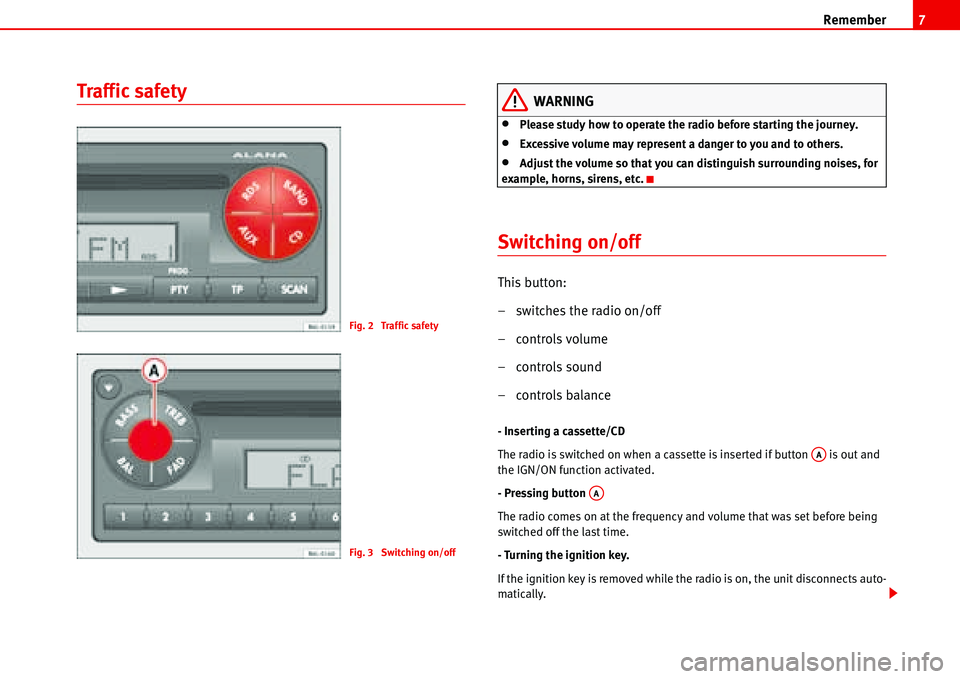
Remember7
Traffic safetyWARNING
•Please study how to operate the radio before starting the journey.
•Excessive volume may represent a danger to you and to others.
•Adjust the volume so that you can distinguish surrounding noises, for
example, horns, sirens, etc.
Switching on/off
This button:
– switches the radio on/off
–controls volume
– controls sound
–controls balance
- Inserting a cassette/CD
The radio is switched on when a cassette is inserted if button is out and
the IGN/ON function activated.
- Pressing button
The radio comes on at the frequency and volume that was set before being
switched off the last time.
- Turning the ignition key.
If the ignition key is removed while the radio is on, the unit disconnects auto-
matically.
Fig. 2 Traffic safety
Fig. 3 Switching on/off
AA
AA
Page 11 of 70
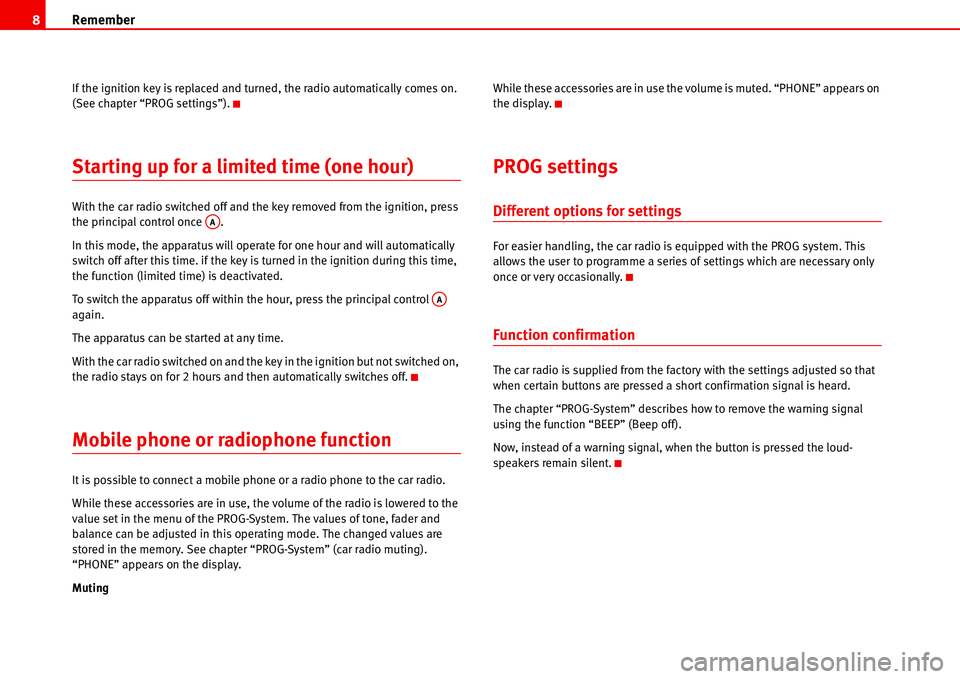
Remember 8
If the ignition key is replaced and turned, the radio automatically comes on.
(See chapter “PROG settings”).
Starting up for a limited time (one hour)
With the car radio switched off and the key removed from the ignition, press
the principal control once .
In this mode, the apparatus will operate for one hour and will automatically
switch off after this time. if the key is turned in the ignition during this time,
the function (limited time) is deactivated.
To switch the apparatus off within the hour, press the principal control
again.
The apparatus can be started at any time.
With the car radio switched on and the key in the ignition but not switched on,
the radio stays on for 2 hours and then automatically switches off.
Mobile phone or radiophone function
It is possible to connect a mobile phone or a radio phone to the car radio.
While these accessories are in use, the volume of the radio is lowered to the
value set in the menu of the PROG-System. The values of tone, fader and
balance can be adjusted in this operating mode. The changed values are
stored in the memory. See chapter “PROG-System” (car radio muting).
“PHONE” appears on the display.
MutingWhile these accessories are in use the volume is muted. “PHONE” appears on
the display.
PROG settings
Different options for settings
For easier handling, the car radio is equipped with the PROG system. This
allows the user to programme a series of settings which are necessary only
once or very occasionally.
Function confirmation
The car radio is supplied from the factory with the settings adjusted so that
when certain buttons are pressed a short confirmation signal is heard.
The chapter “PROG-System” describes how to remove the warning signal
using the function “BEEP” (Beep off).
Now, instead of a warning signal, when the button is pressed the loud-
speakers remain silent.
AA
AA
Page 13 of 70

Brief instructions 10
If there is a compact disc interchanger or Auxiliary device connected to the car
radio and a CD is inserted, it is possible to switch directly between these two
sound sources using the keys and .
For example:
You are listening to the radio. If the button is pressed briefly the CD will
start to play. By pressing the button the CD stops and the compact disc
interchanger or device is activated.
To return to the radio function, press or .
Security
To prevent your car radio from being stolen, when leaving the
vehicle check:
–the code has been activated
–and you are carrying the removable control panel.
Display
This gives visual information about all the major functions when in radio, CD
or AUX mode.
With the PROG system selected, the functions of the corresponding level are
viewed.
Numerical keypad
The numerical keypad is necessary to store or activate programmes, to adjust
play settings, to search for stations with the PTY code and to activate or deac-
tivate the antitheft protection (Code).
CDAUX
CDAUX
BANDRDS
Fig. 6 Numerical keypad
Page 18 of 70
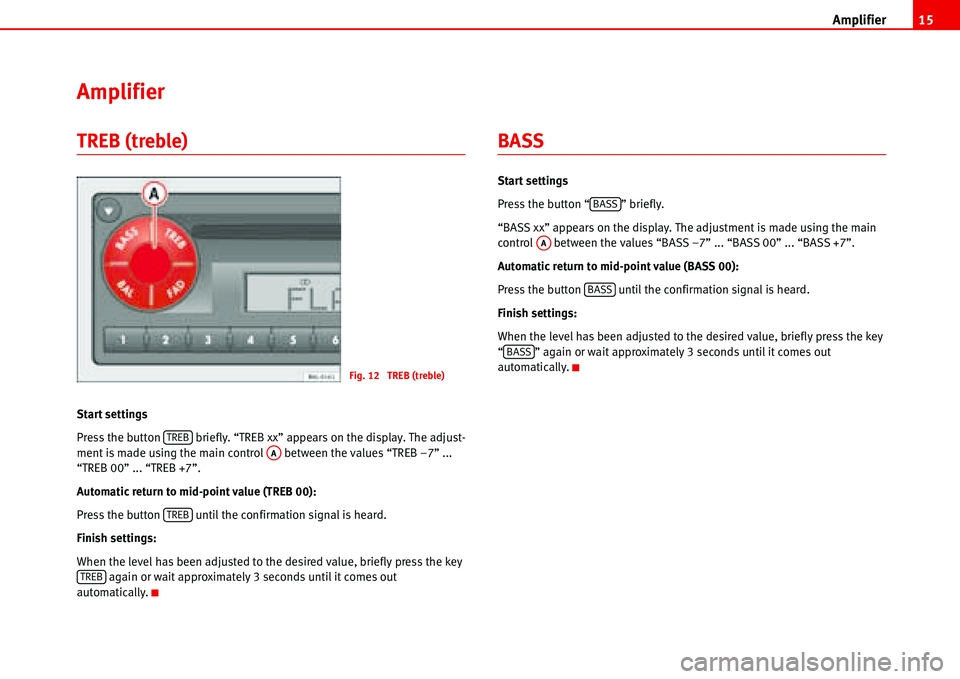
Amplifier15
Amplifier
TREB (treble)
Start settings
Press the button briefly. “TREB xx” appears on the display. The adjust-
ment is made using the main control between the values “TREB –7” ...
“TREB 00” ... “TREB +7”.
Automatic return to mid-point value (TREB 00):
Press the button until the confirmation signal is heard.
Finish settings:
When the level has been adjusted to the desired value, briefly press the key
again or wait approximately 3 seconds until it comes out
automatically.
BASS
Start settings
Press the button “ ” briefly.
“BASS xx” appears on the display. The adjustment is made using the main
control between the values “BASS –7” ... “BASS 00” ... “BASS +7”.
Automatic return to mid-point value (BASS 00):
Press the button until the confirmation signal is heard.
Finish settings:
When the level has been adjusted to the desired value, briefly press the key
“ ” again or wait approximately 3 seconds until it comes out
automatically.
Fig. 12 TREB (treble)
TREBAA
TREB
TREB
BASS
AA
BASS
BASS
Page 19 of 70
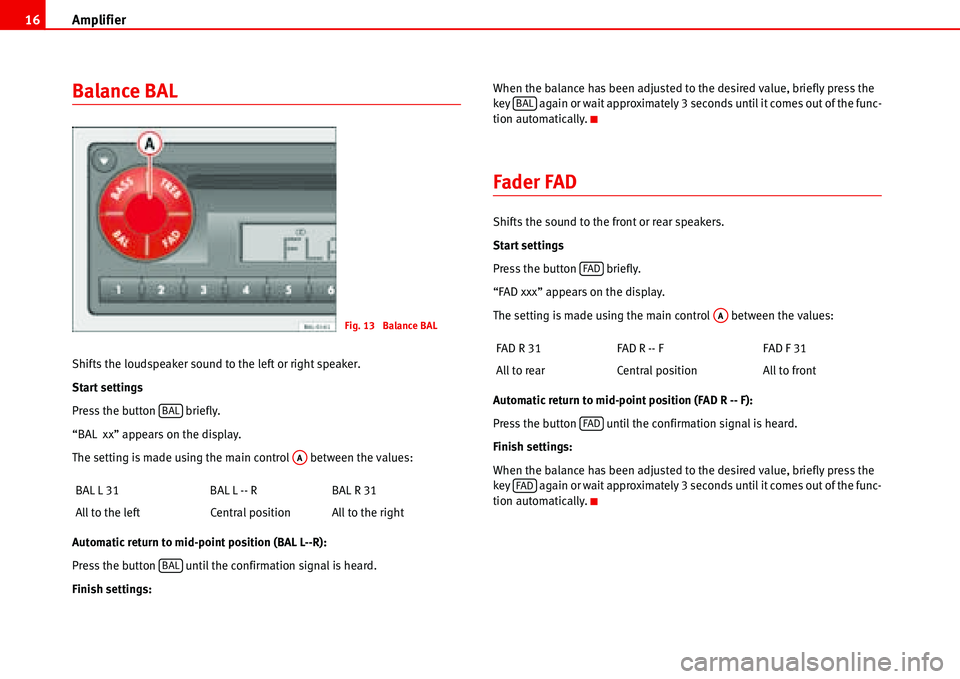
Amplifier 16
Balance BAL
Shifts the loudspeaker sound to the left or right speaker.
Start settings
Press the button briefly.
“BAL xx” appears on the display.
The setting is made using the main control between the values:
Automatic return to mid-point position (BAL L--R):
Press the button until the confirmation signal is heard.
Finish settings:When the balance has been adjusted to the desired value, briefly press the
key again or wait approximately 3 seconds until it comes out of the func-
tion automatically.
Fader FAD
Shifts the sound to the front or rear speakers.
Start settings
Press the button briefly.
“FAD xxx” appears on the display.
The setting is made using the main control between the values:
Automatic return to mid-point position (FAD R -- F):
Press the button until the confirmation signal is heard.
Finish settings:
When the balance has been adjusted to the desired value, briefly press the
key again or wait approximately 3 seconds until it comes out of the func-
tion automatically. BAL L 31 BAL L -- R BAL R 31
All to the left Central position All to the right
Fig. 13 Balance BAL
BAL
AA
BAL
FAD R 31 FAD R -- F FAD F 31
All to rear Central position All to front
BAL
FAD
AA
FAD
FAD
Page 24 of 70

Radio21
Tuning FM stations using the automatic
search
Select FM1 or FM2 waveband. On the screen, “FM 87.50” for example, is
displayed.
To start the automatic search, press the button or .
The search stops at the next station.
The automatic search in FM wavebands works with two sensitivity levels. If no
station is found during the first search along the reception waveband while
searching for stations with a high field intensity (local stations), the radio
makes a second search for stations with a lower field intensity.Manual tuning of the frequency
Select FM1 or FM2 waveband.
Hold the or button down until the sound is heard and “MAN” and
the frequency is displayed briefly.
Tune to the desired frequency by pressing the or buttons. If these
buttons are pressed briefly, the shift is in steps (of 50 KHz) and if the
buttons are held down, the frequencies change rapidly.
Alternative Frequency selection (AF)
RDS FM radio stations can transmit their signal at different frequencies. Your
radio automatically chooses the strongest signal for the selected station. If
you are driving through an area with bad coverage, each automatic re-tune
will result in short breaks in the audio. In order to avoid this, turn the AF func-
tion off.
Turning AF function on/off.
Keep the key pressed until the confirmation signal sounds. The AF func-
tion will be alternatively enabled or disabled.
The AF function status is also stored in the memory when a radio station is
stored and will be enabled again when a preset station is selected.
Fig. 20 Tuning stations
using the automatic
search
�‚�b
A1
A2�‚�b
A3�‚�b
TP
Page 28 of 70
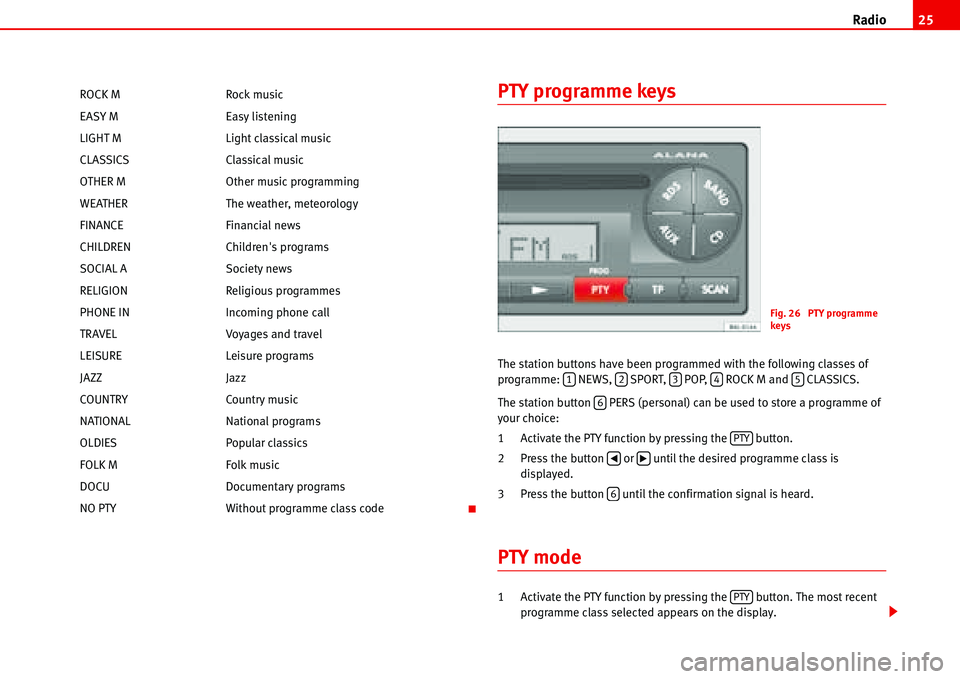
Radio25
PTY programme keys
The station buttons have been programmed with the following classes of
programme: NEWS, SPORT, POP, ROCK M and CLASSICS.
The station button PERS (personal) can be used to store a programme of
your choice:
1 Activate the PTY function by pressing the button.
2 Press the button or until the desired programme class is
displayed.
3 Press the button until the confirmation signal is heard.
PTY mode
1 Activate the PTY function by pressing the button. The most recent
programme class selected appears on the display. ROCK M Rock music
EASY M Easy listening
LIGHT M Light classical music
CLASSICS Classical music
OTHER M Other music programming
WEATHER The weather, meteorology
FINANCE Financial news
CHILDREN Children's programs
SOCIAL A Society news
RELIGION Religious programmes
PHONE IN Incoming phone call
TRAVEL Voyages and travel
LEISURE Leisure programs
JAZZ Jazz
COUNTRY Country music
NATIONAL National programs
OLDIES Popular classics
FOLK M Folk music
DOCU Documentary programs
NO PTY Without programme class code
Fig. 26 PTY programme
keys
12345
6
PTY
�‚�b
6
PTY